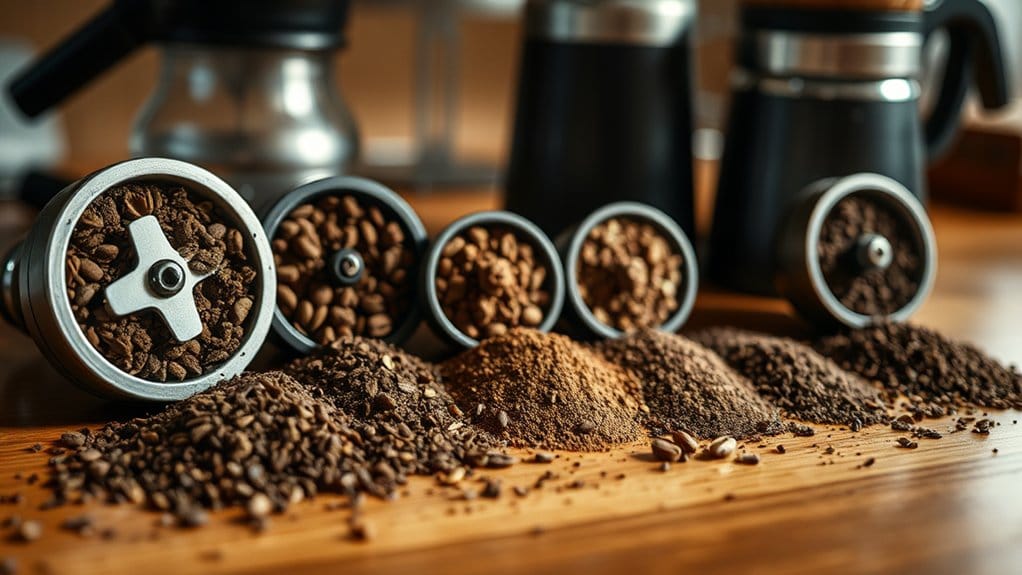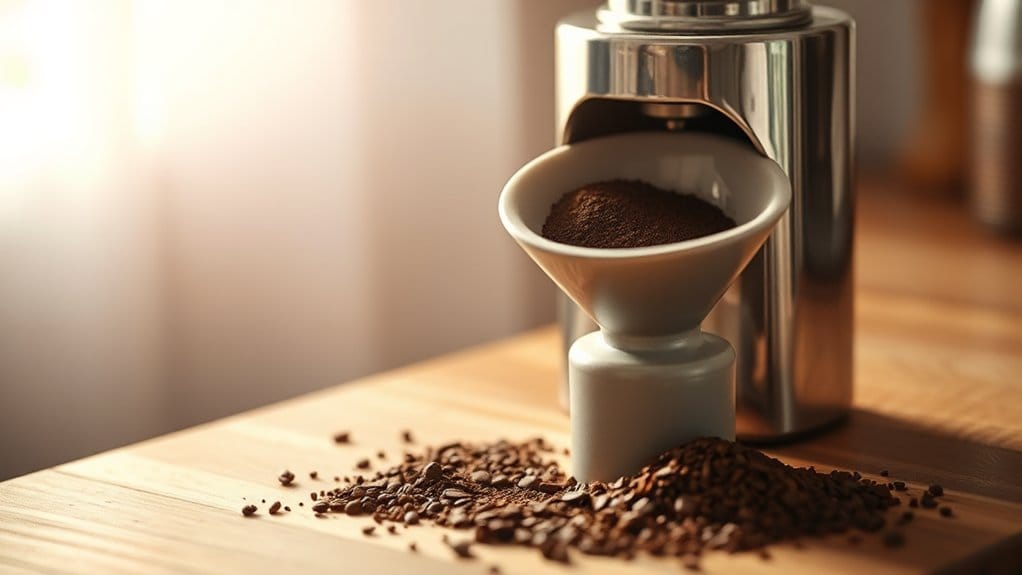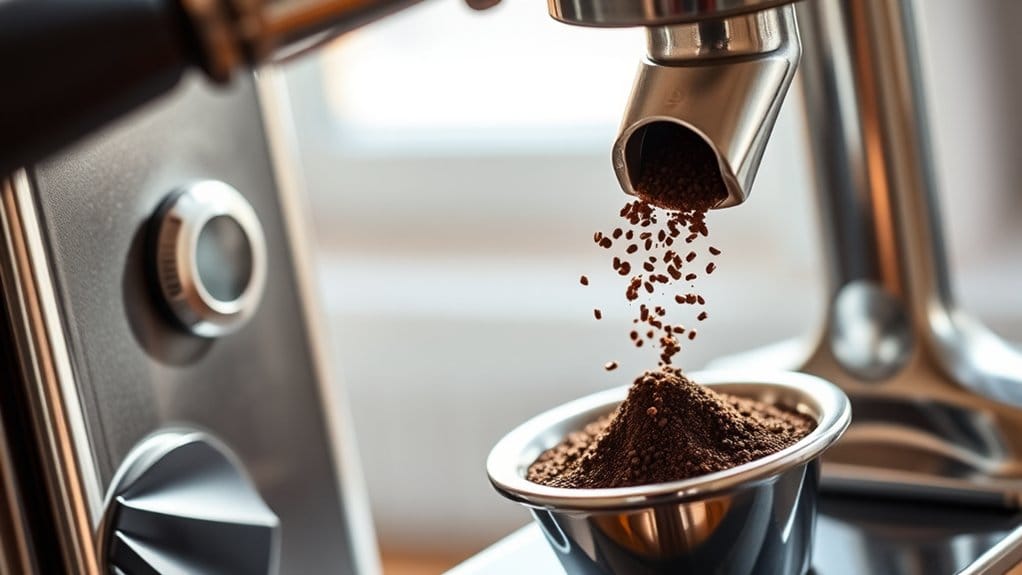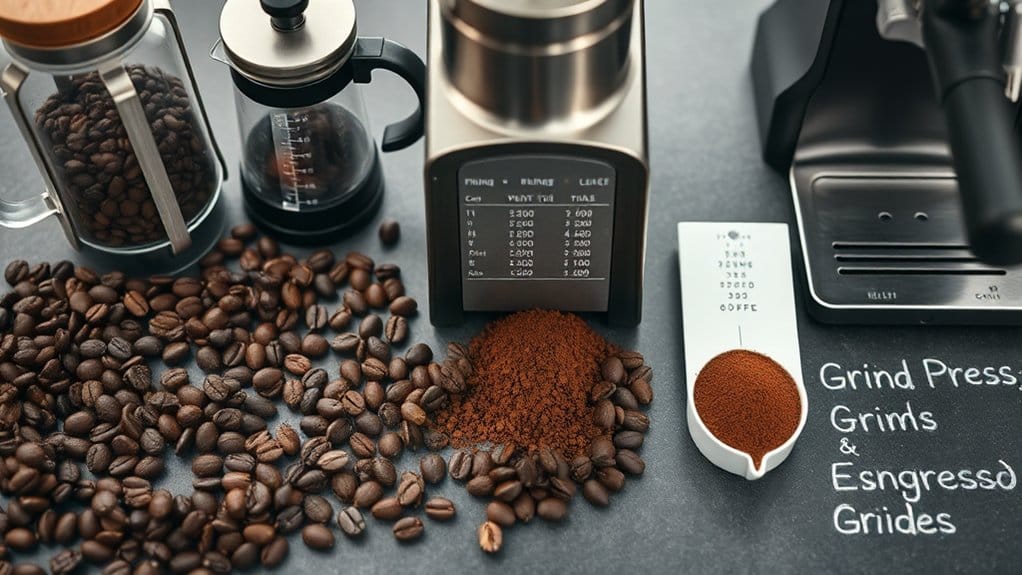Physical Address
304 North Cardinal St.
Dorchester Center, MA 02124
Physical Address
304 North Cardinal St.
Dorchester Center, MA 02124

Getting the right coffee grind is key to a great brew! For cold brew, go for an extra coarse grind, like chunky sea salt. For a French press, stick with a coarse grind, and your brew won’t turn bitter. Switch to medium-coarse for pour-over methods to balance flavors. If you’re into espresso, you’ll need a fine grind—think sand. Curious how to keep your grind consistent? There’s so much more to discover!

When you think of making cold brew coffee, the right grind can really make a difference—especially when you choose an extra coarse grind.
This grind looks a bit like chunky sea salt, which helps achieve that smooth, mild flavor you love. The larger particles allow water to soak in gradually, pulling out delicious flavors without too much bitterness. Plus, it means no clogging in your filters during those long immersion periods! Grinding increases surface area significantly helps extract the optimal flavors from your coffee grounds without adding any unwanted bitterness. Using a coarse grind also aids in achieving even extraction, ensuring that your cold brew is perfectly balanced. You don’t want your coffee tasting like overcooked veggies, right? For the best results, a burr grinder is your best buddy—it promises a uniform grind. Additionally, using freshly ground beans will further enhance your overall flavor extraction for a truly enjoyable cup.
Coarse grind is your secret weapon for brewing delicious French press and percolator coffee. Imagine coffee grounds resembling chunky sea salt—perfectly visible yet satisfying to the touch. Using a burr grinder is a great way to achieve a consistent coarse grind.
With a French press, steep those coarse grinds for about four minutes. This guarantees great flavor without the gritty aftermath of fine particles sneaking through. Regularly using the right grind size in your brewing process ensures a consistent and enjoyable experience.
And for percolators? Coarse grounds are your friends too. They prevent bitterness as water cycles through efficiently, allowing for optimal percolation of flavor. This method is vital for achieving a bold flavor profile and a satisfying aroma.
If you ever feel tempted to go finer, keep in mind that can lead to a muddy brew! So, stick to that rock salt texture for the best cup.
Enjoy the ritual, and savor each sip like it’s crafted just for you—because, well, it totally is!

Moving from the chunky magic of coarse grind, let’s examine the medium-coarse grind, a wonderful fit for pour-over coffee. This grind sits perfectly between coarse and medium, resembling rough sand or coarse sea salt.
It’s like finding a comfy middle seat on a crowded bus—just right!
With medium-coarse grind, you’ll achieve a balanced extraction, avoiding the bitterness of finer grinds during ensuring rich flavor. It works wonderfully with cone-shaped filters like Chemex, letting the water flow just right. Balancing brew time and grind size is essential to prevent under or over-extraction for optimal flavor. It’s important to note that using Chemex Bonded Filters can enhance the overall clarity of your brew.
Think of it as the Goldilocks of coffee grounds—never too fast or too slow!
As you brew, aim for a total extraction time of 2.5 to 4 minutes. Enjoy that delightful cup! Isn’t coffee just the best?
If you’re looking to brew a fantastic cup of coffee, you can’t go wrong with a medium grind for siphon and steep-and-release methods. This grind size is perfect for letting water flow evenly, leading to smooth extraction.
Since siphon brewing relies on vacuum pressure, you’ll want that medium grind to prevent any coffee grounds from sneaking through the filter.
Steep-and-release is a fun method, blending immersion and drip techniques, and it too benefits from that medium grind—ensuring balanced flavors every time. Additionally, mastering techniques like controlled agitation can elevate your extraction and enhance flavor consistency.
Plus, with steep times usually between 1 to 4 minutes, you’ll get to savor your coffee quickly! So grab your grinder, and let’s unlock some delicious brews together. Trust me, you’ll taste the difference!

When you sink your teeth into the world of espresso, understanding the fine grind is essential. This grind’s texture resembles sand, ensuring your coffee extracts evenly for that perfect shot.
When you brew espresso, aim for an extraction time of 25-30 seconds. A fine grind gives you rich, complex flavors, whereas it also boosts acidity and caffeine levels. Just a little too fine, though, and you risk over-extraction—yikes! To avoid that, be consistent with your grind size.
Think of it like baking; precision really matters! Use fresh beans and adjust your machine settings, and you’ll enjoy a smooth body with a thick crema atop your espresso. To achieve this consistency, it’s crucial to experiment with various grind sizes depending on your coffee beans.
Now, let’s get brewing!
Have you ever savored a cup of Turkish coffee? If you have, you know the magic lies in the extra fine grind, which measures between 40 to 220 microns. This powdery texture, finer than table salt, creates that rich, thick brew you love.
When you simmer these ultra-fine grounds in a cezve, the flavor explosions are intense! Plus, the grounds remain in your cup, giving that velvety mouthfeel. Historically, this grind has shaped coffee culture across the Middle East for centuries, turning every cup into a delightful ritual.
Just remember, getting that perfect grind might take a specialized burr grinder—not a blade grinder. Trust me, you wouldn’t want to miss out on the unique charm of a well-prepared Turkish coffee!

To achieve consistent grind sizes, you’ll want to adopt a few key techniques that make all the difference. Start by using a burr grinder, as it offers uniformity like a perfectly aligned row of coffee beans—no surprises here! Regularly calibrate your grinder and keep those burrs clean. You wouldn’t want clumpy grounds ruining that morning brew, right?
Visual checks against textures help too. Think table salt for fine grinds or breadcrumbs for coarse. Adjust your grind size in small increments, and test brew after each change. Remember, achieving optimal extraction is key to maximizing flavor.
Oh, and remember to store your beans well, as fresh is always a winner. With these simple tips, you’ll master the art of grinding and savor each flavorful sip!
Yes, grind size definitely affects coffee strength and bitterness. Finer grinds extract more flavor and strength, but risks bitterness. Coarser grinds yield weakness and sourness. Adjusting grind size helps you balance these factors for your perfect brew.
Grind size directly influences brewing time by affecting extraction efficiency. Finer grinds need shorter contact time to avoid bitterness, whereas coarser grinds require more time for water to fully extract flavors. Adjust accordingly for best results.
When choosing the best grinders for home use, consider models like the Baratza Encore for versatility, or the 1Zpresso Q Air for precision. They deliver consistent results across various brew methods, ensuring great coffee every time.
There’s no universal grind size for all brewing methods. Each technique needs specific grind sizes to optimize extraction and flavor, so you’ll need to experiment to find what works best for your preferred brewing style.
You can mix grind sizes in one brew, but it often leads to uneven extraction and muddled flavors. For a balanced cup, stick to a consistent grind size tailored for your brewing method instead.